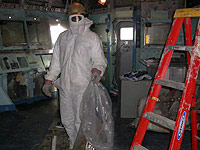Shipyard Employment eTool
Shipbreaking >> Ladders

Ladders are used in shipbreaking to allow workers to gain access to multiple levels, and in some cases to work from. Hazards associated with the use of ladders include falls from the ladder caused by structural failures, poor placement, and inappropriate work practices.
Fiberglass, aluminum, and ship's ladders that are also used in the shipyard and their maintenance requirements are addressed under the general requirements. [29 CFR 1915.72(a)]
Note: There are specific requirements for construction of portable ladders that are less than 30 feet and 30-60 feet. [29 CFR 1915.72(b) and (c)]

Additional requirements for ladders use:
- Scaffolds (Staging) [29 CFR 1915.71]
- Access to Vessels [29 CFR 1915.74]
- Access and Guarding of Drydocks and Marine Railways [29 CFR 1915.75]
- Access to Cargo Spaces and Confined Spaces [29 CFR 1915.76]
- Working Surfaces [29 CFR 1915.77]
- Lifesaving Equipment [29 CFR 1915.158(b)(5)]
Note: Confined space entry is one of the leading hazards associated with barge cleaning. Review the Shipbreaking: Confined or Enclosed Spaces and Other Dangerous Atmospheres chapter for information on how to protect workers from this hazard.

The safe construction and use of ladders can protect workers who are required to access multiple levels and those who work from the ladders. Training workers on safe ladder use and how to assess the condition of the ladder before use is an important aspect of a safety and health program.

Potential Hazards
- Structural failure of the ladder or its components, causing the worker to fall.
- Inappropriate ladder placement (such as ladder angle), causing the worker to fall. See Figure 4.
- Unsecured ladder causing the ladder and worker to fall.
- Inappropriate work practices (such as over-extending, climbing with equipment in hand, not facing ladder when climbing down), causing the worker to fall.
- Electrical shock or electrocution when using metal ladders.

Requirements and Example Solutions
- Defective ladders must not be used and must be removed immediately. [29 CFR 1915.72(a)(1)]
- When splicing ladders, special precautions are required. [29 CFR 1915.72(a)(2)]
- Portable ladders used for access must be secured and extend at least 36 inches above the upper landing. [29 CFR 1915.72(a)(3)] See Figure 5.
- Manufactured portable metal or wood ladders must be in accordance with ANSI standards. [29 CFR 1915.72(a)(4) and (a)(6)]
- Portable metal ladders must not be used near electrical shock hazards (such as conductors and electric arc welding). [29 CFR 1915.72(a)(5)]

Additional Requirements
- Hand lines or tool bags must be used to keep workers' hands free when using ladders. [29 CFR 1915.131(a)]
- Only one worker is allowed on a ladder unless the ladder is designed for additional workers. [29 CFR 1910.25(d)(2)(ii)]
- Portable straight ladders must have a 4-to-1 ratio. Ladders must not be used in a horizontal position as platforms, runways, or scaffolds. [29 CFR 1910.25(d)(2)(i)] See Figure 6.
- Portable ladders must be used when the ship's ladders in the cargo holds are defective. [29 CFR 1915.76(a)(3)]
Additional requirements for ladder use

